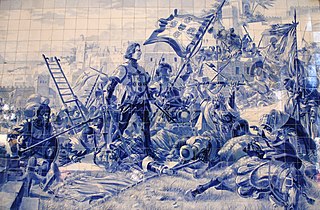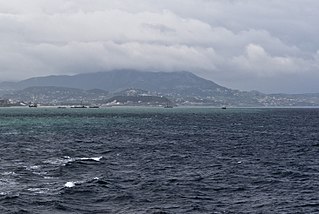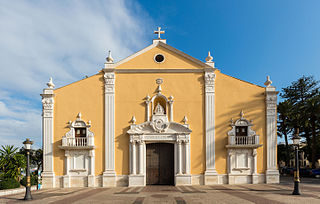
Melilla is a Spanish autonomous city located on the north coast of Africa, sharing a border with Morocco, with an area of 12.3 km2 (4.7 sq mi). Melilla is one of two permanently inhabited Spanish cities in mainland Africa, the other being Ceuta. It was part of the Province of Málaga until 14 March 1995, when the city's Statute of Autonomy was passed.

Duarte, known in English as Edward and called the Philosopher or the Eloquent, was King of Portugal from 1433 until his death. He was born in Viseu, the son of John I of Portugal and his wife, Philippa of Lancaster. Edward was the oldest member of the "Illustrious Generation" of accomplished royal children who contributed to the development of Portuguese civilization during the 15th century. As a cousin of several English kings, he became a Knight of the Garter.

Tétouan is a city located in northern Morocco. It lies along the Martil Valley and is one of the two major ports of Morocco on the Mediterranean Sea, a few miles south of the Strait of Gibraltar, and about 60 km (40 mi) E.S.E. of Tangier. In the 2014 Moroccan census the city recorded a population of 380,787 inhabitants. It is part of the administrative division Tanger-Tetouan-Al Hoceima.

The conquest of Ceuta by the Portuguese on 21 August 1415 marks an important step in the beginning of the Portuguese Empire in Africa.

The Marinid dynasty or Banu abd al-Haqq was a Sunni Muslim dynasty of Zenata Berber descent that ruled Morocco from the 13th to the 15th century.
Muhammed III was a son of Muhammed II al-Faqih and the third Nasrid ruler of the Emirate of Granada in Al-Andalus on the Iberian Peninsula. On April 8, 1302 he ascended the Granadan Sultan's throne after the death of his father Muhammed II al-Faqih. During the first few weeks of his reign, Muhammed III negotiated peace treaties with the kingdoms of Castile and Aragon.
Nasr, full name Abu al-Juyush Nasr ibn Muhammad, was a son of Muhammed II al-Faqih and the fourth Nasrid ruler of the Moorish Emirate of Granada in Al-Andalus on the Iberian Peninsula. On March 14, 1309, he ascended the throne after his brother Muhammed III was dethroned in a palace revolution. At his accession, Granada was in a very dangerous three-front war against Castile, Aragon and the Marinid Sultanate, due to his predecessor's disastrous foreign policy. In the first year of his rule he made peace with Granada's three enemies. He lost Ceuta as well as yielded Algeciras and Ronda to the Marinids in exchange for peace in September 1309. Granada lost Gibraltar to a Castilian siege in September, but successfully defended Algeciras until peace was agreed in January 1310.

Abu ar-Rabi Sulayman (reigned 28 July 1308 – 23 November 1310) was a Marinid ruler of Morocco. Son or grandson of Abu Yaqub Yusuf and brother of Abu Thabit Amir, whom he succeeded in 1308, at the age of 19.

Abu Yaqub Yusuf an-Nasr was a Marinid ruler of Morocco. He was the son of Abu Yusuf Ya'qub, whom he succeeded in 1286. He was assassinated in 1307.

The Algeciras Heliport is a public heliport in Algeciras. It was inaugurated on July 1, 2010 by the Minister of Development, José Blanco. It was the second helipad of the network AENA after Ceuta Heliport. Construction had started in February 2009. It provides transport to Ceuta and other areas in the Campo de Gibraltar. The only airport existing in the area is the one in the neighbouring British Overseas Territory of Gibraltar.
Abu Zakariya Yahya ibn Ziyan al-Wattasi (abū zakarīyā' yaḥyā ben ziyān al-waṭṭāsī Arabic: أبو زكرياء يحيى بن زيان الوطاس was a vizier of the Marinid sultan of Fez, regent and effective strongman ruler of Morocco from 1420 until 1448. He is the founder of the Wattasid dynasty of viziers and later sultans, and as such often designated as Yahya I in Wattasid lists. He was also known by his nickname Lazeraque, as found in Portuguese chronicles.

Ksar es-Seghir, also known by numerous other spellings and names, is a small town on the Mediterranean coast in the Jebala region of northwest Morocco, between Tangier and Ceuta, on the right bank of the river of the same name. Administratively, it belongs to Fahs-Anjra Province and the region of Tanger-Tetouan-Al Hoceima. By the census of 2004, it had a population of 10,995 inhabitants.

Dom Fernando de Noronha was a 15th-century Castilian-Portuguese nobleman. He was the 2nd Count of Vila Real, a title which he acquired and shared by his marriage to Brites de Menezes, 2nd Countess of Vila Real and the third Portuguese governor of Ceuta from 1437.
The Siege of Ceuta of 1419 was fought between the besieging forces of the Marinid Sultanate of Morocco, led by Sultan Abu Said Uthman III, including allied forces from the Emirate of Granada, and the Portuguese garrison of Ceuta, led by Pedro de Menezes, 1st Count of Vila Real. After the loss of the city in a surprise attack in 1415 known as the Conquest of Ceuta, the Sultan gathered an army four years later and besieged the city. The Portuguese gathered a fleet under the command of princes Henry the Navigator and John of Reguengos to relieve Ceuta. According to the chroniclers, the relief fleet turned out to be quite unnecessary. In a bold gambit, D. Pedro de Menezes led the Portuguese garrison in a sally against the Marinid siege camp and forced the lifting of the siege before the relief fleet even arrived.

The history of Moorish Gibraltar began with the landing of the Muslims in Hispania and the fall of the Visigothic Kingdom of Toledo in 711 and ended with the fall of Gibraltar to Christian hands 751 years later, in 1462, with an interregnum during the early 14th century.
Abu Said Uthman III was Marinid ruler of Morocco from 19 March 1398 to 1420, the last effective ruler of that dynasty. He ascended to the throne at the age of sixteen. He succeeded his brother, Abu Amir Abdallah ibn Ahmad. His forces were involved in an unsuccessful attempt to acquire Gibraltar from the Emirate of Granada in 1410. In 1415 the Portuguese seized the port of Ceuta. Abu Said Uthman III failed in an attempt to recover Ceuta, and was shortly after assassinated. His vizier gained control of the kingdom, establishing the Wattasid dynasty of rulers of Morocco.

The Church of Santa María de África is a Roman Catholic church in the Spanish city of Ceuta which is located in a small Spanish exclave on the north coast of Africa.

The Royal Walls of Ceuta are a line of fortification in Ceuta, an autonomous Spanish city in north Africa. The walls date to 962 in its oldest part and the most modern parts to the 18th century. They remain largely intact, with the exception of some outworks, and are listed as a Spanish Property of Cultural Interest.
The Siege of Almería was an unsuccessful attempt by Aragon to capture the city of Almería from the Emirate of Granada in 1309. The city defenders repelled multiple assaults, and by the end of December James II of Aragon, who personally led the siege, asked for a truce and subsequently withdrew from Granadan territory.
















